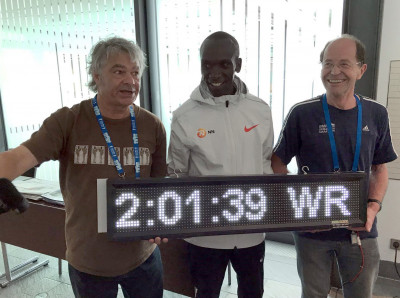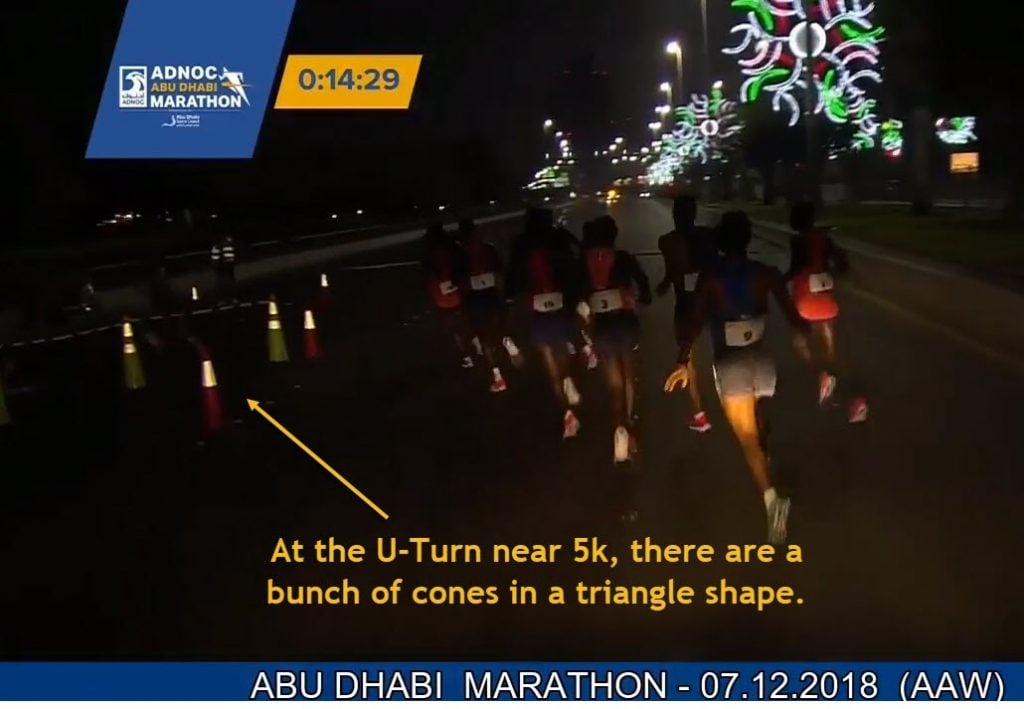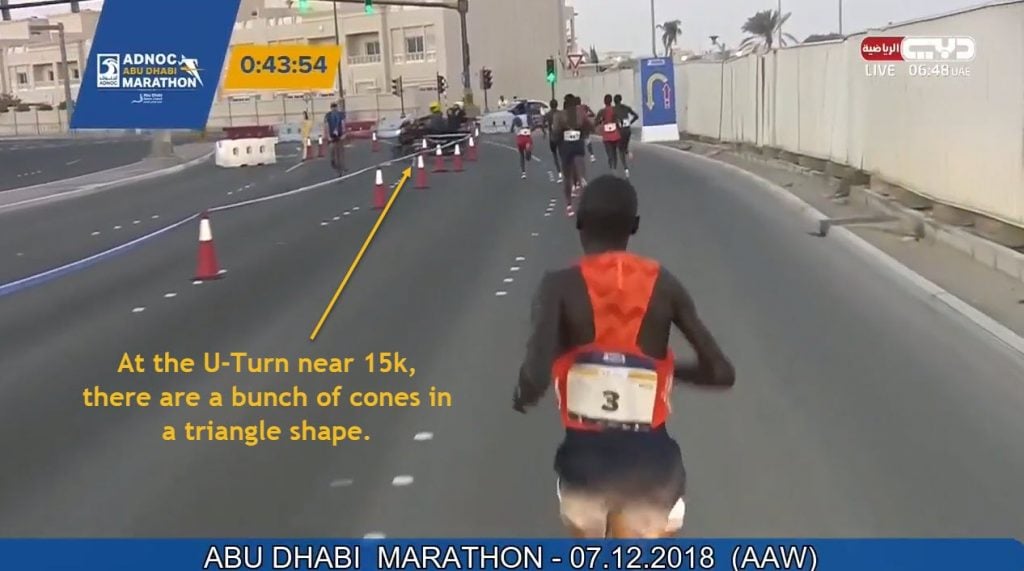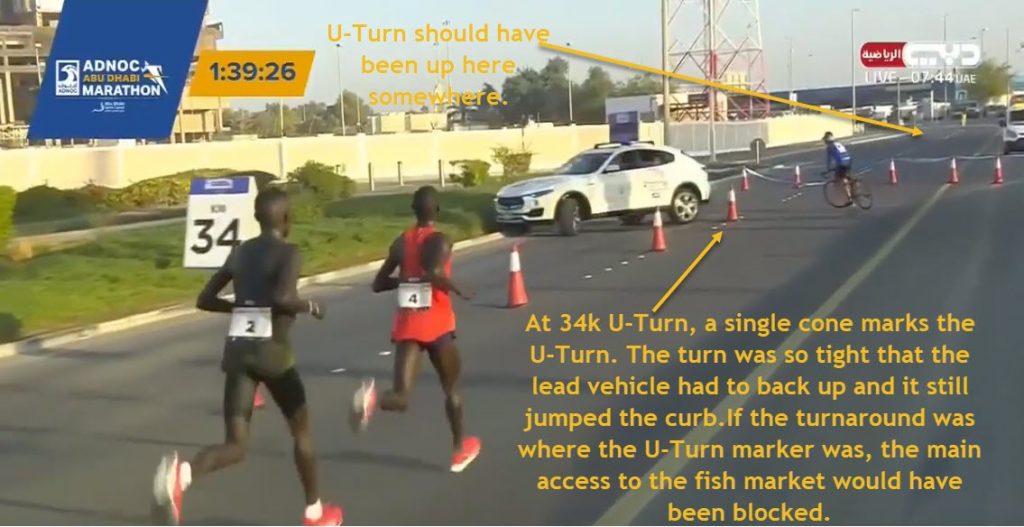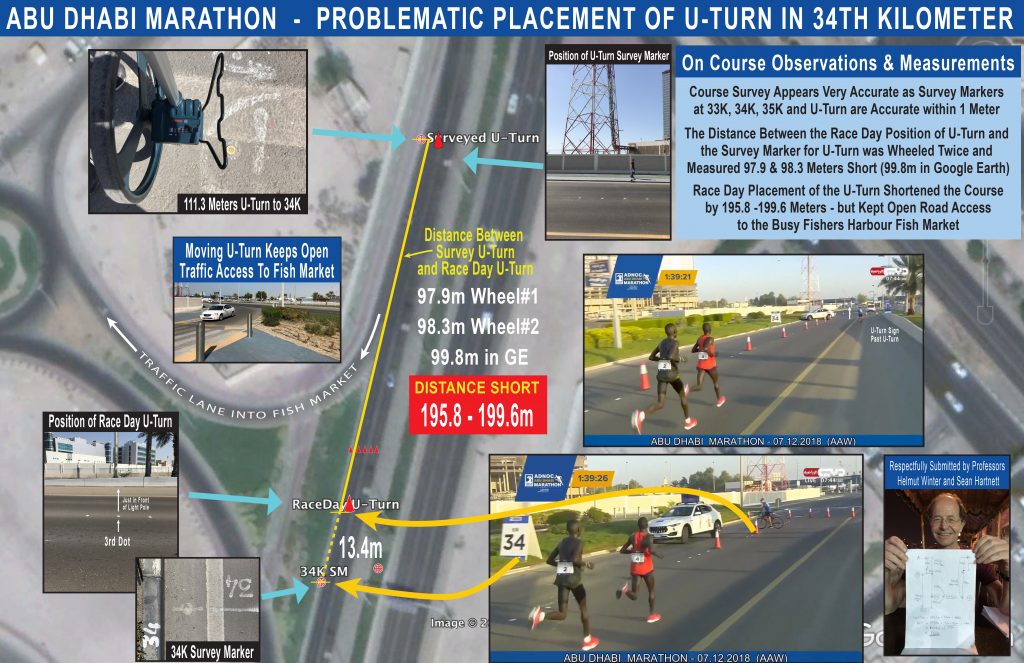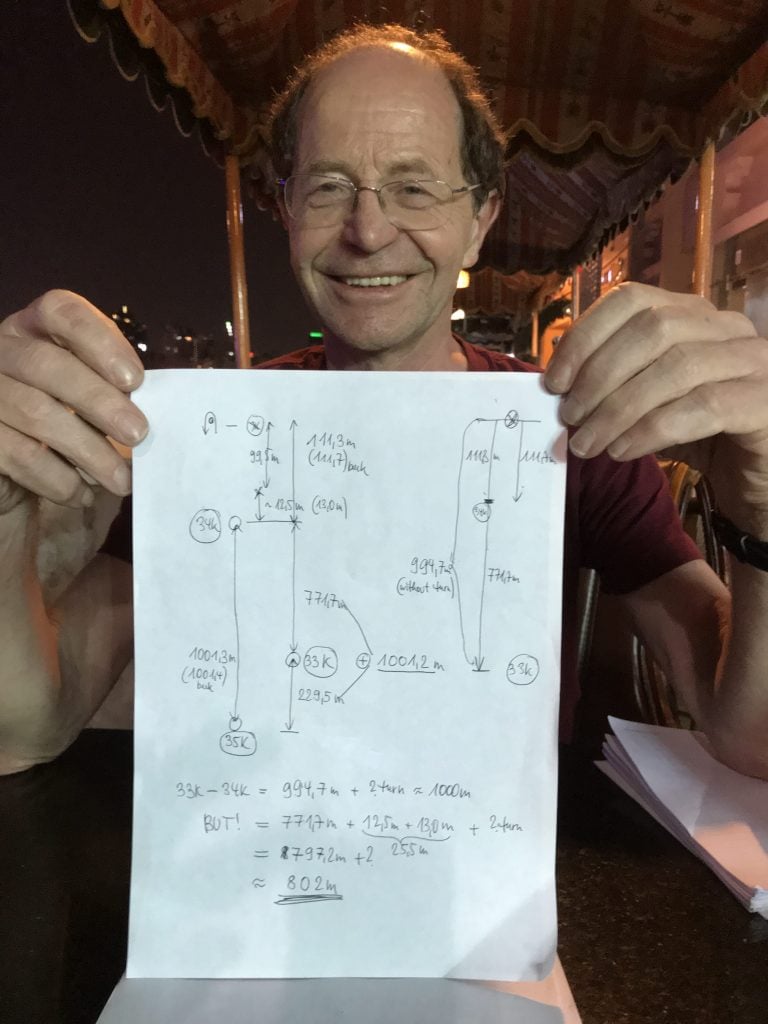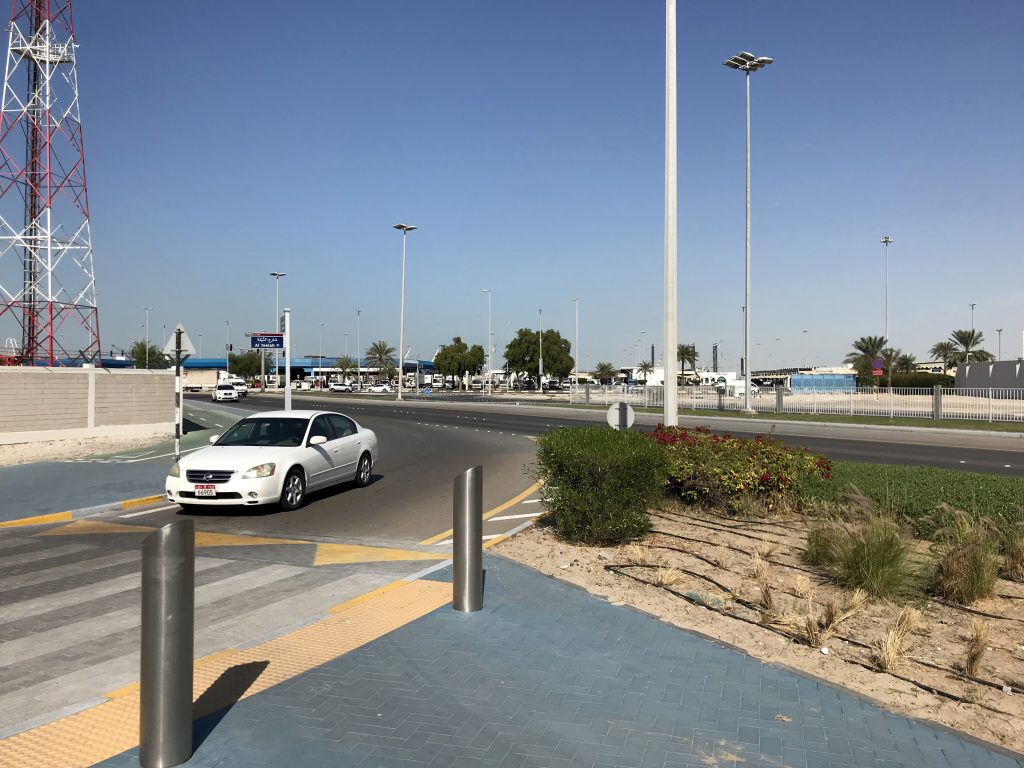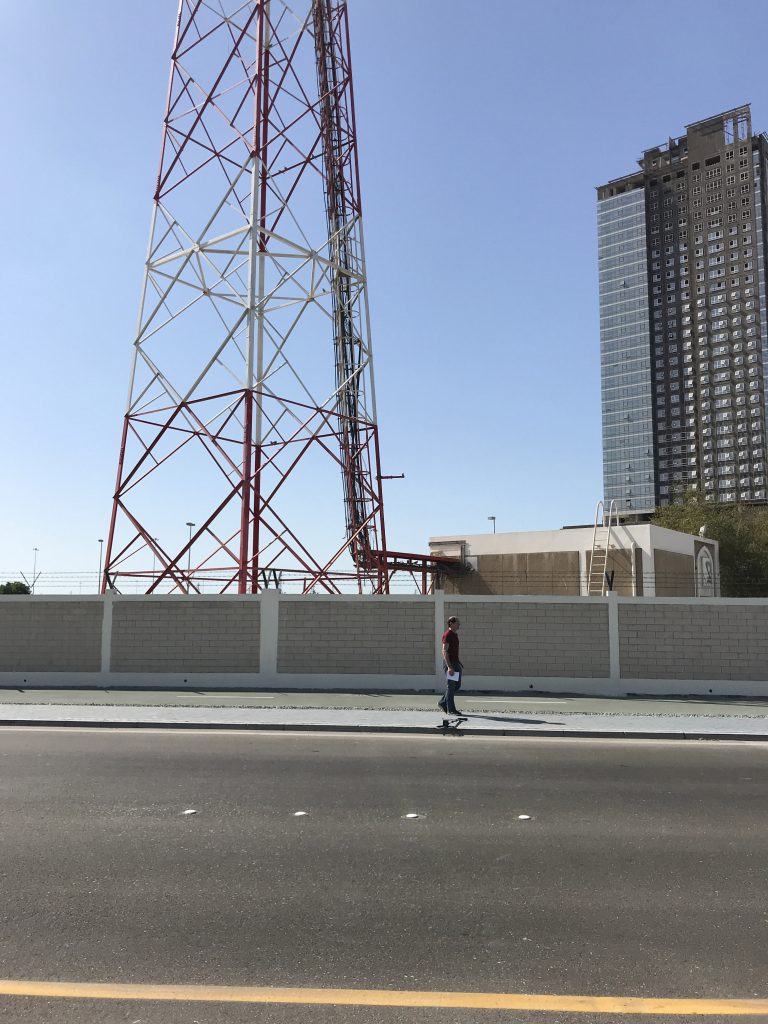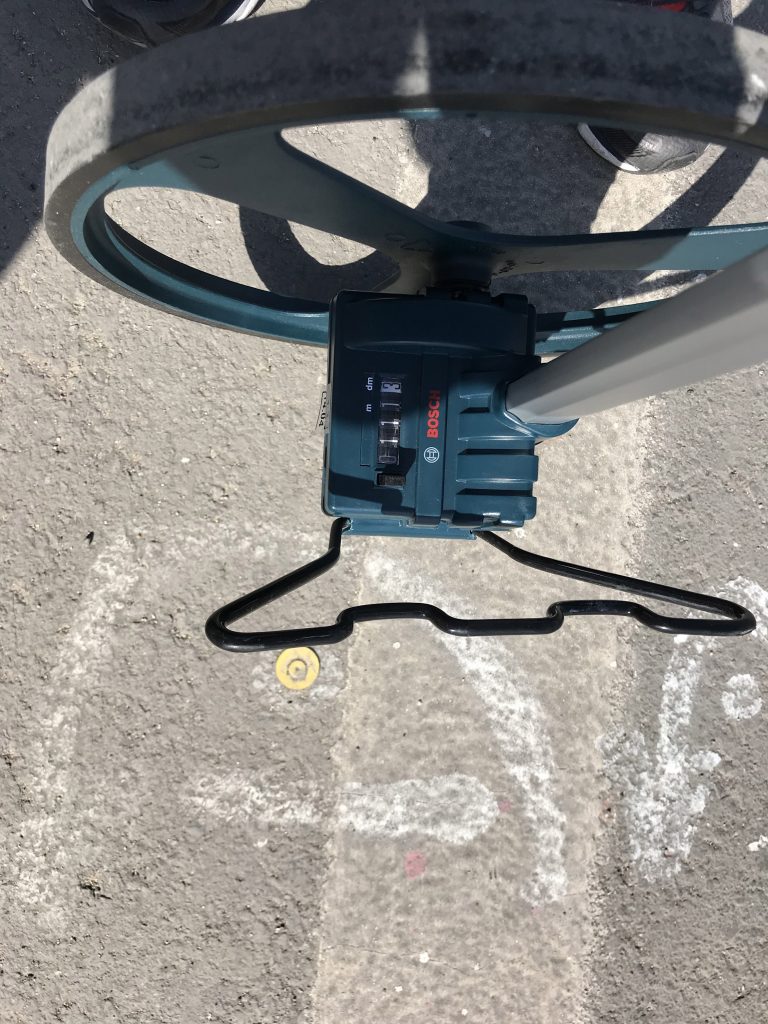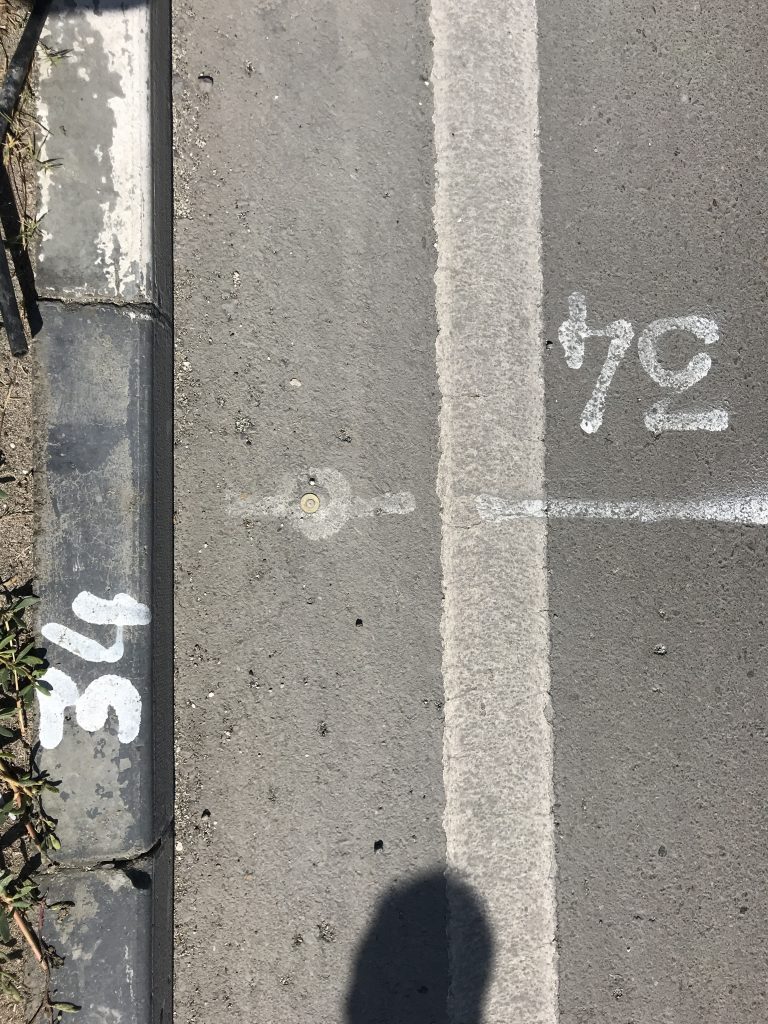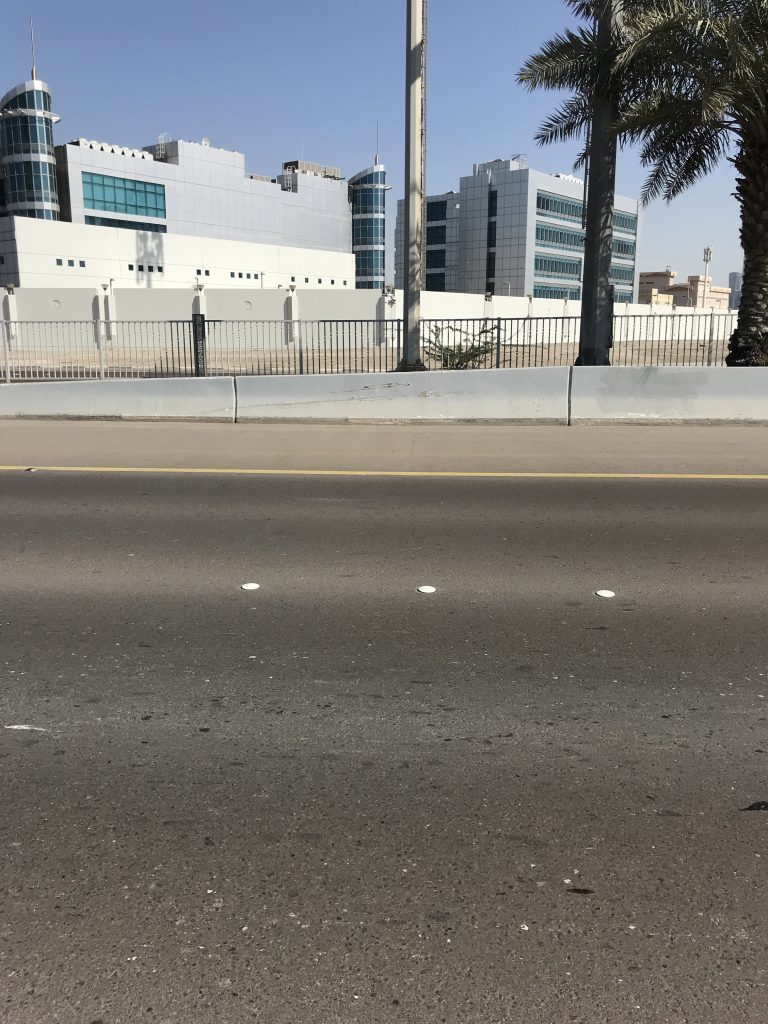After Re-Measuring the Course, Here’s Definitive Proof That the 2018 Abu Dhabi Marathon Was Short
By Robert Johnson
February 13, 2019
A re-measurement of the disputed portion of the course used for the 2018 Abu Dhabi Marathon has revealed that the course was approximately 200 meters short. Instead of running 42.195 kilometers, the runners ran almost exactly 42 kilometers — somewhere between 195.8 and 199.6 meters less than they should have — according to marathon experts Sean Hartnett and Helmut Winter, who conducted the re-measurement last week.
Background
The inaugural Abu Dhabi Marathon was held on December 7 and produced spectacular winning times of 2:04:03 for the men and 2:20:16 for the women. But immediately after the race was over, I began to wonder if the course was the full 42.2-km distance. The times were fast, but what really stood out is that both the men’s and women’s races featured ridiculously fast splits between 30 and 35km.
According to the timing website, the two men’s leaders allegedly ran the 30 to 35k segment in 13:55 — that is 1:57:27 marathon pace. That split would easily be the fastest flat 5k segment in marathon history. The leading women’s duo were credited with a similarly egregious split of 15:55 between 30 and 35k — that’s 2:14:19 pace. Making the split all the more unbelievable was the fact that the 30 to 35k segment featured a 180-degree turn; if it wasn’t for that, the splits would have been even faster.
So I was supposed to believe that four different runners ran four of the greatest 5k segments in marathoning history all in the same race on the same flat portion of the course in less-than-ideal conditions? Sorry, there is no way I could believe that, particularly once I determined it wasn’t wind-aided (there was little wind and that portion of the course was out and back). Maybe if one person destroyed everyone else in the pack I could buy it, but not when four people supposedly did it within a matter of minutes.
The 30 to 35k segment certainly seemed short, but that doesn’t necessarily mean the entire course was short — sometimes an intermediate timing mat is misplaced on a course. But the timing data showed no corresponding “long” split to make up for it. Therefore I concluded the course had to be short and wrote an article stating exactly that.
My musings on the matter caught the eye of the American Hartnett and the German Winter, two men known in elite road running circles as “The Professors of the Marathon.” Hartnett, a geographer at the University of Wisconsin-Eau Claire, and Winter, a retired professor of physics at Humboldt University in Berlin, are the inventors of the of “Pace Display System,” which is used during major half marathon and marathon events around the globe to show splits and projected finish times on the lead vehicles. It has been used in 18 of the 20 fastest times in marathon history, including recent world records by Wilson Kipsang, Dennis Kimetto, and Eliud Kipchoge in Berlin.
Winter measured the disputed section of the Abu Dhabi course on Google Earth and on December 12 agreed with my assertion that the course was short, stating that he hoped race organizers would quickly release the race’s certification report. He also said that if we didn’t hear back from race officials, he would go to Abu Dhabi and measure the disputed portion of the course himself in February after his Pace Display System was used at the nearby RAK Half Marathon.
Winter and Hartnett Take Matters Into Their Own Hands
On Friday, two months and one day after the Abu Dhabi Marathon, Winter and Hartnett did exactly that. After checking the accuracy of a BOSCH professional GMW32 measuring wheel (which had been “calibrated by the national bureau of standards located in Braunschweig, Germany, to an absolute accuracy of about 2 * 10E-4”) that Winter had taken with him to the Middle East on a portion of the RAK course, they made the 2.5-hour drive from Ras al Khaimah to Abu Dhabi.
Once there, Hartnett says they concluded the Abu Dhabi course was short within a matter of minutes. They quickly found the nails and markers left by the course measurer for all of the key points of interest — the 33km mark, the 34km mark, 35km mark, and, most importantly, the point where the runners were supposed to make a U-turn just before 34k.
They were very impressed by the measurer’s work. Of his work, Winter wrote, “We have not the slightest doubt that the course was measured with a high level of expertise and according to the rules.”
The problem was it was clear the actual U-turn that the runners ran in the race came well before the U-turn spot marked by the course measurer. Their best estimate is that the error caused the 34th kilometer to be between 195.8 and 199.6 meters short.
Hartnett has a theory as to what happened. If the runners had run the full distance to the turnaround point, they would have blocked the main entrance to the local fish market — a market which Hartnett said was “hopping” when they were doing their measurement. Fish markets are very busy early in the mornings — which is exactly when the marathon was being held. So perhaps someone — with or without permission — moved the cones to let traffic get to the fish market and never moved them back.
Hartnett’s hypothesis makes sense. The way the cones were set up at the U-turn just before 34k was unlike any of the other U-turns in the course. At the U-turns just before 5k and just before 15k, there were a bunch of cones set up in a triangle shape to help the runners make a more gradual U-turn as shown here.
Compare that to the U-Turn just before 34k where the racers turned sharply around a single cone. The turn was so sharp, the lead vehicle couldn’t make it without backing up and even then it had to partially jump the curb.
“There was something fishy about those cones, and I’m inclined to believe it’s related to the fish market,” quipped Hartnett.
On December 17, I reached out to Abu Dhabi race director Andrea Basso to ask whether the course was measured accurately and whether it was the correct distance. Basso said he would get back to me by the end of the week, but that didn’t happen.
After reaching out again on January 31, Basso said he was still waiting for the official measurement report but expected it to appear within the next day or so and added that once he got it that he would “act quickly.” Finally, on February 8, Basso said he had received the full measurement report from the official measurer on February 4 and had compared the information in the report with the race video.
“Soon we are going to send an official communication to the IAAF, and after that we will provide a full explanation to the various media outlets that enquired about the Abu Dhabi Marathon,” Basso wrote. “I would have loved to come to an end much sooner, but without the official measurement report it was impossible for us to make a thorough analysis of what has happened.”
Below you will see a statement from Hartnett and Winter detailing the work they did in Abu Dhabi, as well as an infographic that Hartnett produced that summarizes their work. Below the infographic, I’ve also included the raw photos in the infographic so you can see them better.
(Talk about this article on our world famous fan forum / messaboard. MB: Vindication: 2 experts just remeasured the Abu Dhabi Marathon course and found it to be a little less than 200 meters short!)
Statement From Helmut Winter and Sean Hartnett
We drove down to Abu Dhabi which is located about 150 km south-west from Dubai. The idea was to inspect the “critical” part of the course between 33 km and 35 km on “Corniche”, a type of boulevard close to the seaside, beaches, and harbour. It took us only a short while to recognize with the help of screenshots from the video of the race the actual spots of the Abu Dhabi course.
We found nails and markers for all three km-points of interest (33, 34, 35 km) and in addition nail and marker for the U-turn point before 34 km. The position of this turning point on race day was a key issue of our investigation.
The measurements of the distances were performed with a wheel BOSCH professional GMW32 – calibrated by the national bureau of standards located in Braunschweig (Germany) to an absolute accuracy of about 2 * 10E-4. We tested this wheel on the reference for the RAK half marathon, 300.0 m of nominal length. This calibration resulted in a length measured to 299.9 m (first calibration by HW) and to 299.9 m (second calibration by John Kunkeler, IAAF Grade A measurer) and was thus in full accord to specifications.
In Abu Dhabi, we measured first the distance between the 34 km and 35 km markers. This resulted in 1001.3 m on the way down (in full traffic!) and 1001.4 m (back). We also inspected the distance from 35 km to 33 km to 229.5 m and from 33 km to 34 km to 771.7 m which adds up to 1000.2 m.
CONCLUSION: We have not the slightest doubt that the course was measured with a high level of expertise and according to the rules (remember: a calibration factor of 1,001 has to be introduced in order to be on the safe side).
So the problem on race day was that the U-turn before 34 km was on the wrong position. The position on race day was only about 12.5 m to 13 m apart from 34 km marker. However, the
measurements from 34 km to the “correct” turning point (nicely marked by a nail) gave 111.3 m and 111.7 (back) (measurement in full traffic).
The distance from 33 km to 34 km via the “correct” turning point thus yields 994.7 m and if one adds about 5 m for changing the lanes there, you end up to more or less 1000 m – as it should be. However, on race day this distance was only 797.2 m plus 5 m so that the distance was about 802 m only.
So ALL runners ran about 200 m less in the race between 33 km and 34 km. This corresponds to a time for the elite of about 35 seconds. A direct conclusion from this data is that the 5 km splits of the eventual winner Marius Kipserem read as:
20 – 25 km 14:42
25 – 30 km 14:42
30 – 35 km 13:55 !!! is equivalent to 14:30 now
35 – 40 km 14:59
CONCLUSION: To the best of our knowledge the “puzzle” with the length of the course in Abu Dhabi is solved. We have no doubt that the rest of the course was correct even on race day. Course measurements are usually performed with a slight cushion of distance, but 200 m is certainly too long, in order to find it compensated in length somewhere on the course.
The first edition if the Abu Dhabi marathon was a great success with super fast times. But by arguments given above, those times cannot find their entry into the record books. Lets us mention finally that we are irritated to a major extent that the organizers were not able up to the moment of this writing to present a clear cut statement on this issue for the public. In this respect were are grateful to LetsRun.Com for initiating the discussion on this issue which triggered our inspection of the course.
Helmut Winter and Sean Hartnett
Infographic From Sean Hartnett
Talk about this article on our world famous fan forum / messaboard. MB: Vindication: 2 experts just remeasured the Abu Dhabi Marathon course and found it to be a little less than 200 meters short!)
Previous 2019 Abu Dhabi Coverage:
- LRC German Expert Believes The Abu Dhabi Marathon Was Between 120 and 130 Meters Short
- LRC Was the Inaugural Abu Dhabi Marathon Course Short? I Think It Was
- MB:Length matters: Here’s why I believe the Abu Dhabi course was short
- LRC Marius Kipserem Upsets Half Marathon WR Holder Abraham Kiptum at Inaugural Abu Dhabi Marathon, But Was The Course Short?
- MB: Official 1st Ever Abu Dhabi Marathon Discussion Thread – Abraham Kiptum goes for some BIG BUCKS! (tonight 9 pm ET)
